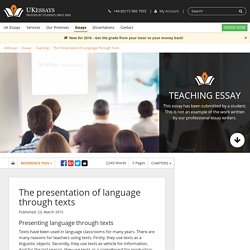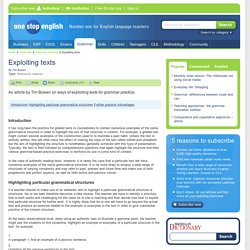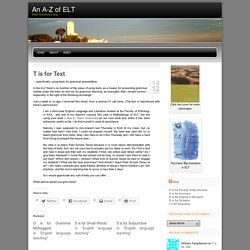

The presentation of language through texts. Presenting language through texts Texts have been used in language classrooms for many years.

There are many reasons for teachers using texts. Firstly, they use texts as a linguistic objects. Secondly, they use texts as vehicle for information. And for the last reason, they use texts as a springboard for production. The most effective texts in learning process are authentic materials. There are several kinds of authentic materials which are audio, visual, printed materials and multimedia materials. Professional Essay Writers Get your grade or your money backusing our Essay Writing Service! Essay Writing Service Authentic audio materials: Authentic visual materials: Images and graphs available on the internet photographs painting and drawings, children's artwork wordless street signs pictures from magazines, postcards, wordless picture books stamps x-rays coins and currency clocks phones Halloween masks and other holiday decorations Authentic printed materials: Authentic multimedia materials:
The relevance of communicative methodology for language teaching in South Africa. By Bill Farquharson Since the emergence of the communicative approach to language teaching in the 1970s, there has been a widespread adoption of the principle within Teaching English to Speakers of Other Languages (TESOL) methodology that language teaching should focus on the learners’ communicative proficiency, rather than mastery of grammatical forms.

Communicative competence The scope of the communicative approach has expanded over the years, but retains the principle that the goal of language teaching should be communicative competence rather than linguistic ‘knowledge’ of a language. It offers tried and tested procedures for the teaching of language systems and skills that “… acknowledge the interdependence of language and communication”.1 In the multilingual context of South Africa, where learners are required to learn one or more ‘additional’ languages, a coherent approach to language teaching is needed across the raft of languages being offered in schools. 1. 2. 3.
A Task-based approach. This article also links to the following activity.Try - Speaking activities - Task-based speaking - planning a night out Present Practice ProduceThe problems with PPPA Task-based approachThe advantages of TBLConclusion Present Practice Produce (PPP) During an initial teacher training course, most teachers become familiar with the PPP paradigm. A PPP lesson would proceed in the following manner. First, the teacher presents an item of language in a clear context to get across its meaning. This could be done in a variety of ways: through a text, a situation build, a dialogue etc.Students are then asked to complete a controlled practice stage, where they may have to repeat target items through choral and individual drilling, fill gaps or match halves of sentences.
The problems with PPP It all sounds quite logical but teachers who use this method will soon identify problems with it: A Task-based approach Task -based learning offers an alternative for language teachers. Exploiting texts. By Tim Bowen An article by Tim Bowen on ways of exploiting texts for grammar practice.

Introduction It has long been the practice for graded texts in coursebooks to contain numerous examples of the same grammatical structure in order to highlight the use of that structure in context. For example, a graded text might contain several examples of the construction used to to illustrate a past habit. Unless the text is skilfully written, this will often have the effect of making the style of the text rather stilted and unrealistic but the aim of highlighting the structure is nonetheless generally achieved with this type of presentation. In the case of authentic reading texts, however, it is rarely the case that a particular text will have numerous examples of the same grammatical structure. Highlighting particular grammatical structures Further practice Matching the beginnings and endings of sentences, e.g.
Choosing the best from a series of options, e.g. Writing the endings of sentences, e.g. n2460 esol teaching skills taskbook unit 4 e teaching grammar 2 grammar from texts. T is for Text. …specifically, using texts for grammar presentation.

In the A-Z there’s no mention of the value of using texts as a means for presenting grammar, neither under the entry for text nor for grammar teaching, an oversight I feel I should correct – especially in the light of the following exchange. Just a week or so ago, I received this email, from a woman I’ll call Irena. (The text is reproduced with Irena’s permission): I am a third-year English Language and Literature student at the Faculty of Philology in XXX, and one of my elective courses this year is Methodology of ELT. We are using your book ( How to Teach Grammar) as our core book and, while it has been extremely useful so far, I do find myself in need of assistance.Namely, I was supposed to micro-teach last Thursday in front of my class, but, no matter how hard I had tried, I could not prepare myself.
What advice would you give Irena?